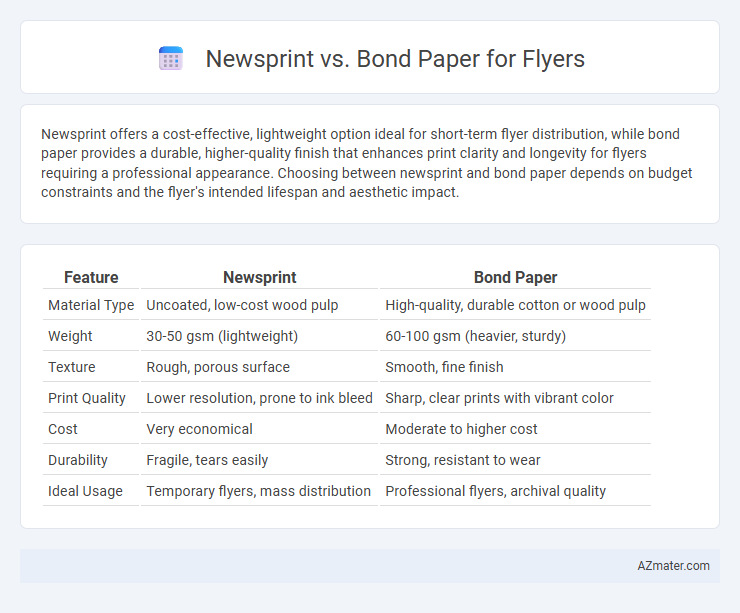Newsprint offers a cost-effective, lightweight option ideal for short-term flyer distribution, while bond paper provides a durable, higher-quality finish that enhances print clarity and longevity for flyers requiring a professional appearance. Choosing between newsprint and bond paper depends on budget constraints and the flyer's intended lifespan and aesthetic impact.
Table of Comparison
| Feature | Newsprint | Bond Paper |
|---|---|---|
| Material Type | Uncoated, low-cost wood pulp | High-quality, durable cotton or wood pulp |
| Weight | 30-50 gsm (lightweight) | 60-100 gsm (heavier, sturdy) |
| Texture | Rough, porous surface | Smooth, fine finish |
| Print Quality | Lower resolution, prone to ink bleed | Sharp, clear prints with vibrant color |
| Cost | Very economical | Moderate to higher cost |
| Durability | Fragile, tears easily | Strong, resistant to wear |
| Ideal Usage | Temporary flyers, mass distribution | Professional flyers, archival quality |
Introduction: Choosing the Right Paper for Flyers
Selecting between newsprint and bond paper for flyers hinges on balancing cost and quality. Newsprint offers an affordable option with a rough texture and lower brightness, suitable for short-term, high-volume distribution. Bond paper provides a smoother finish, higher durability, and enhanced print clarity, making it ideal for professional presentations and longer-lasting marketing materials.
What is Newsprint Paper?
Newsprint paper is a low-cost, lightweight paper primarily composed of recycled pulp, widely used for printing newspapers and flyers due to its high absorbency and quick ink drying properties. It typically has a rough texture and lower brightness compared to bond paper, which can affect image sharpness and color vibrancy in flyers. Newsprint's affordability makes it ideal for mass distribution, although it is less durable and more prone to yellowing over time than higher-grade bond paper.
What is Bond Paper?
Bond paper is a high-quality, durable paper made from cotton or a blend of cotton and wood pulp, commonly used for official documents, letterheads, and flyers. It has a smooth surface and higher brightness compared to newsprint, making printed text and images appear sharper and more professional. Bond paper's strength and resistance to smudging or fading make it ideal for flyers requiring a polished and long-lasting presentation.
Print Quality: Newsprint vs Bond Paper
Newsprint offers a lightweight texture with lower brightness, resulting in less vibrant print quality, ideal for budget-friendly, short-term flyers. Bond paper features higher brightness and smoothness, providing sharper, more vivid prints with better ink absorption, making it suitable for professional, high-quality flyers. Choosing between newsprint and bond paper depends on the desired print sharpness, color vibrancy, and flyer durability.
Durability and Lifespan Comparison
Newsprint offers lower durability and a shorter lifespan, making it prone to yellowing and tearing over time, which limits its use for flyers intended for long-term distribution. Bond paper has a higher tear resistance and better aging qualities, ensuring that flyers maintain their appearance and structural integrity longer. Choosing bond paper enhances flyer durability and lifespan, especially for promotional materials requiring extended visibility.
Cost Effectiveness: Budget Considerations
Newsprint offers a cost-effective solution for high-volume flyer printing due to its lower price per sheet compared to bond paper, making it ideal for budget-conscious campaigns. Bond paper, while slightly more expensive, provides a higher quality appearance and durability that can justify the additional investment for premium flyers. Evaluating print quantity and desired flyer lifespan helps determine the optimal balance between cost efficiency and material quality.
Environmental Impact and Sustainability
Newsprint, often made from recycled fibers and containing fewer chemical additives, has a lower environmental impact compared to bond paper, which typically requires more virgin pulp and bleaching agents. The biodegradability and recyclability of newsprint contribute to its sustainability, whereas bond paper, especially when coated or treated, may hinder recycling processes and increase landfill waste. Choosing newsprint for flyers supports eco-friendly printing practices by reducing resource consumption and promoting a circular paper economy.
Suitable Uses: When to Choose Newsprint or Bond
Newsprint is ideal for short-term, cost-effective flyers such as event promotions, community newsletters, or bulk advertisements due to its lightweight and inexpensive nature. Bond paper suits professional, high-quality flyers like business proposals, official invitations, or marketing materials requiring durability and a polished appearance. Choosing between newsprint and bond paper depends on the flyer's purpose, budget constraints, and the desired visual impact.
Visual Appeal: Color and Texture Differences
Newsprint offers a coarse texture and muted color palette that limits its visual appeal for flyers, resulting in a more rustic or traditional look. Bond paper features a smooth surface and brighter, whiter tones, enhancing vibrancy and sharpness in printed colors ideal for eye-catching flyers. The choice between newsprint and bond paper significantly impacts flyer presentation, with bond paper delivering superior color fidelity and tactile quality.
Final Recommendations: Selecting the Best Option for Your Flyers
Choose newsprint for budget-friendly flyers requiring high volume distribution with acceptable print quality and short lifespan. Opt for bond paper when durability, crisp print clarity, and professional appearance are essential to leave a lasting impression. Consider flyer purpose, target audience, and budget constraints to ensure the optimal balance between cost and quality.

Infographic: Newsprint vs Bond Paper for Flyer
 azmater.com
azmater.com